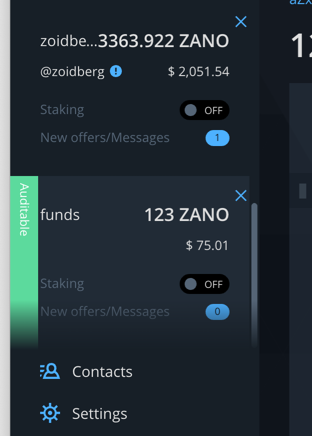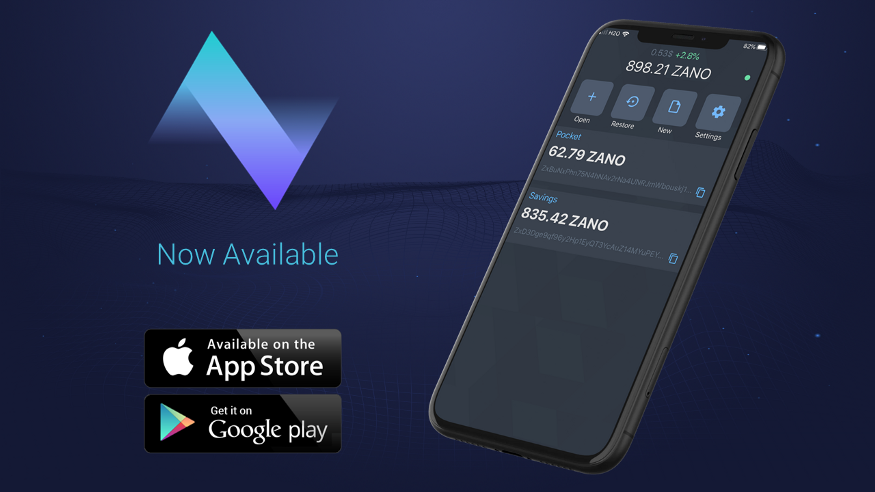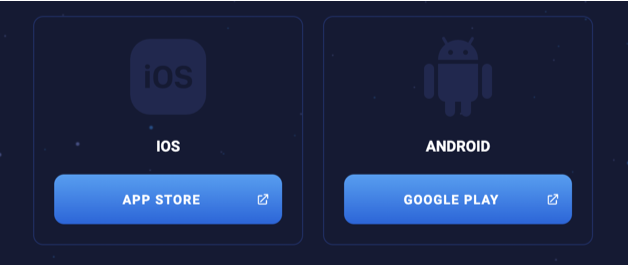Zano Development Update (27–7–2020) - Auditable wallets, mobile app release and new team member
Hello everyone!
As you may have noticed the Zano team hasn’t had much news lately, but today we are excited to share three very important announcements!
New release with Auditable Wallets
First of all, we are excited to finally announce the release of the very important update, which implements the ability to create auditable wallets.
To put in simple terms, you are now able to create a special type of wallet — auditable wallet — and share a special tracking seed from it, which enables anyone that you share this tracking seed with to create a tracking wallet , this is a wallet that monitors the movement of funds and the balance of the original wallet, but does not allow access to funds.

Basically this feature makes it possible for public funds to share state of their wallets and prove consistency. We implemented this feature because the Zano team believes it is very important to remain transparent and straightforward for our community, in the coming days we will prepare our staking infrastructure for transferring the dev funds to these audit wallets.
We’ll publish an elaborated article about that in the next few days, where we explain how it works, how it looks and how to use it.
Mobile wallet

Almost any solid cryptocurrency now has its own mobile wallets, this is much more convenient than the full-node desktop version (although not always safer): our mobile application allows you to get up and running quickly and not have to wait until gigabytes of blocks in the entire history of the blockchain are downloaded and verified, and under normal circumstances it’s ready to send and receive payments immediately after launch.
For many bitcoin-like cryptocurrencies and ERC-20 tokens, the creation of a mobile application usually takes no more than a month — the principle of operation of these blockchains allows you to do most of the work on the server side, and the application receives ready-made data almost immediately. For CryptoNote-family projects, the situation is a little more complicated: due to the nature of the privacy of the blockchain, the server side is unable to determine which of the transactions belong to the wallet of the mobile application without knowing the private information of this wallet. Because of this, all blockchain transactions must be “shown” to the mobile wallet, in this regard, it is necessary to transfer all the wallet logic to the mobile device, and organize effective interaction with the server.
We’ve spent the last few months developing our own mobile application and our own server protocol from the ground up. The application consists of two parts — the front end, written in React Native, and the guts based on C++ native library.
The front-end of the mobile application is not open source at the moment, since we do not want to allow attackers to effortlessly release alternative versions of the mobile application and scam our holders. However, the native wallet library is in the open source repository and is essentially based on the Zano reference wallet implementation.
We conducted a thorough beta testing of the application (thanks to the community volunteers), and we hope that we have fixed all the bugs, but nevertheless, we ask you to use the application guardedly in the first month and not transfer all your assets to it. Very IMPORTANT(!!!): always write down the seed phrase after creating a new wallet. Feel free to report any problems to our discord channel #mobile-bug-reports or to the channel https://www.reddit.com/r/Zano/ or to our mail: support at our domain.

New team member
And finally — the hottest and most exciting news we want to share is mathematician researcher Anton Sokolov has joined the Zano team! Anton is a nuclear physicist by education, most of his professional life he was engaged in software engineering and various research for IT projects related to mathematics.
We’ve been in touch with Anton for the last couple of years, sharing discussions of blockchain-related technologies and global events in the industry. In the fall of last year, Anton made several publications regarding the theoretical possibility of implementing auditable wallets in his blog, we have mentioned some of them in this article. For the last months Anton has been working on theoretical work dedicated to log-size ring signatures. Despite the fact that Anton was working on this paper as an independent researcher, we closely followed his progress, and now we decided to join our efforts together in order to bring Zano’s privacy to a new level.
We are well aware that a new scheme in cryptography will require a huge amount of verification work, and at the moment the work is being peer reviewed by independent experts. We also want to invite everyone to participate in the review of this 40-pages of math puzzles and share your opinion in a discussion, please write your questions or comments on the work in our discord server in the #research channel (or personally crypto_zoidberg if you found a completely shameful error in that work :) ).
Benefits of a signature.
By implementing the Lin2-Xor signature (that’s the name of this theoretical work) we will be able to provide Zano users with an opportunity to use transactions with anonymity set way beyond any other CryptoNote family can afford at this moment.
The fact is that the signatures existing now give a linear dependence of the size of the signature itself on the number of decoys, and, accordingly, the linear speed of verification. Thus, by setting a high number of mixins, the user creates a large transaction (which is not the biggest problem), but more importantly, the verification of such a transaction will also be slow. This factor is currently the cornerstone of privacy for all cryptonote-family projects, and the number of mixins is a compromise between speed/size and network throughput (for example, in many projects the mixin is set to 10 by default).
Lin2-Xor signature theoretically allows for a logarithmic relationship between the number of decoys and the size of transactions. This means that we can set mixins at a level from up to 1000, keeping the reasonable size and processing speed of transactions. This level of anonymity set will allow us to take Zano’s privacy to a whole new level, and we believe this technology will turn out to be groundbreaking!
